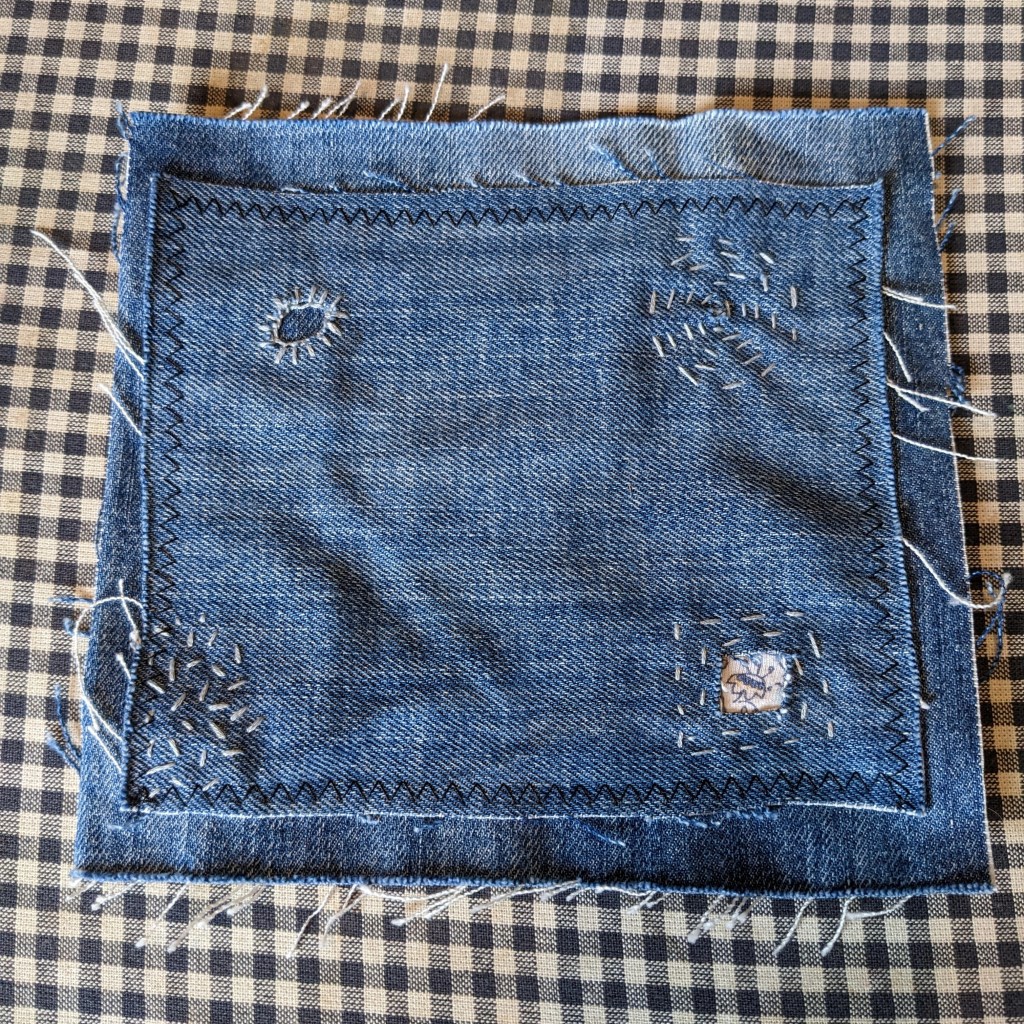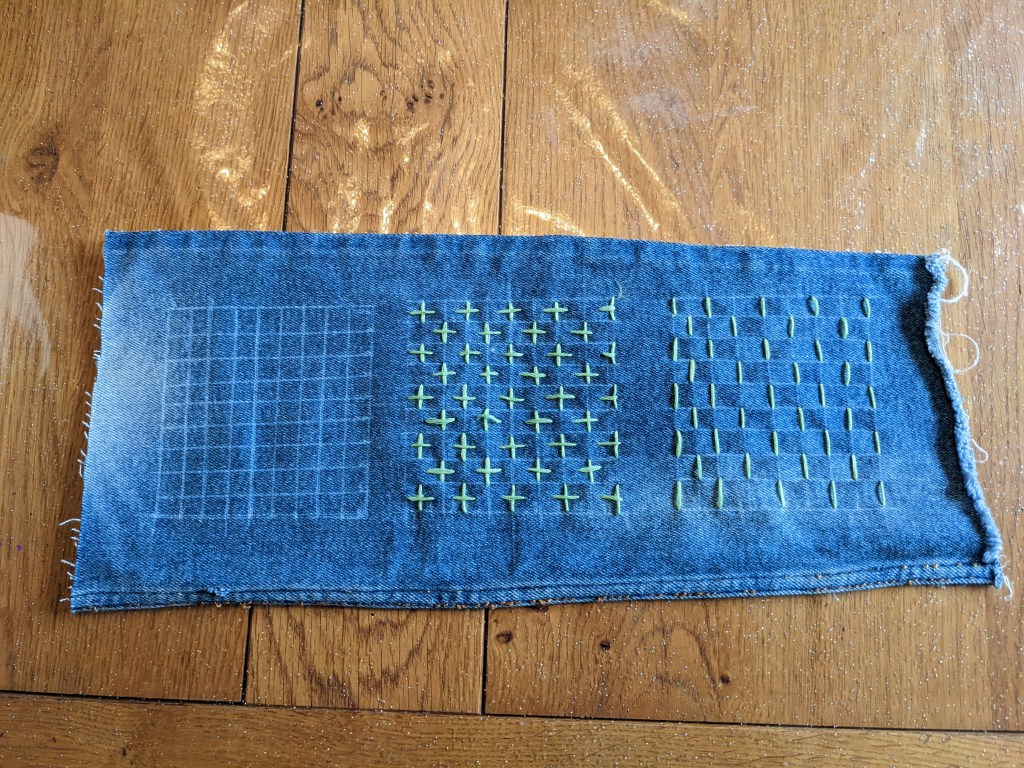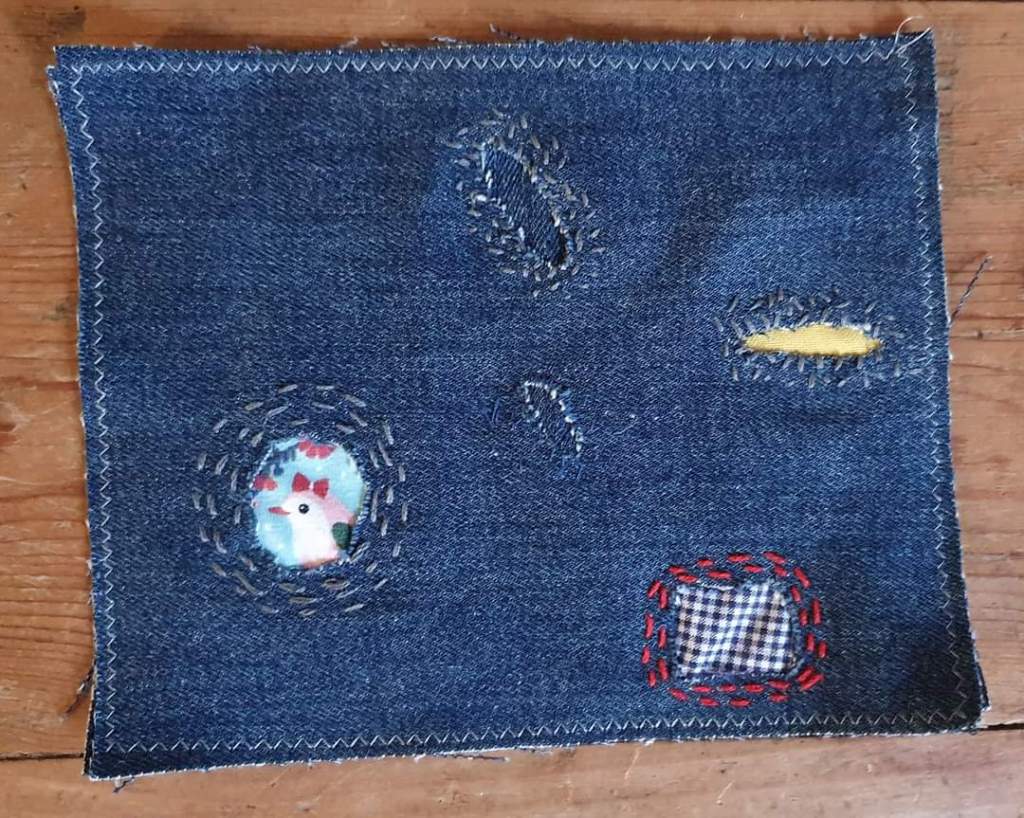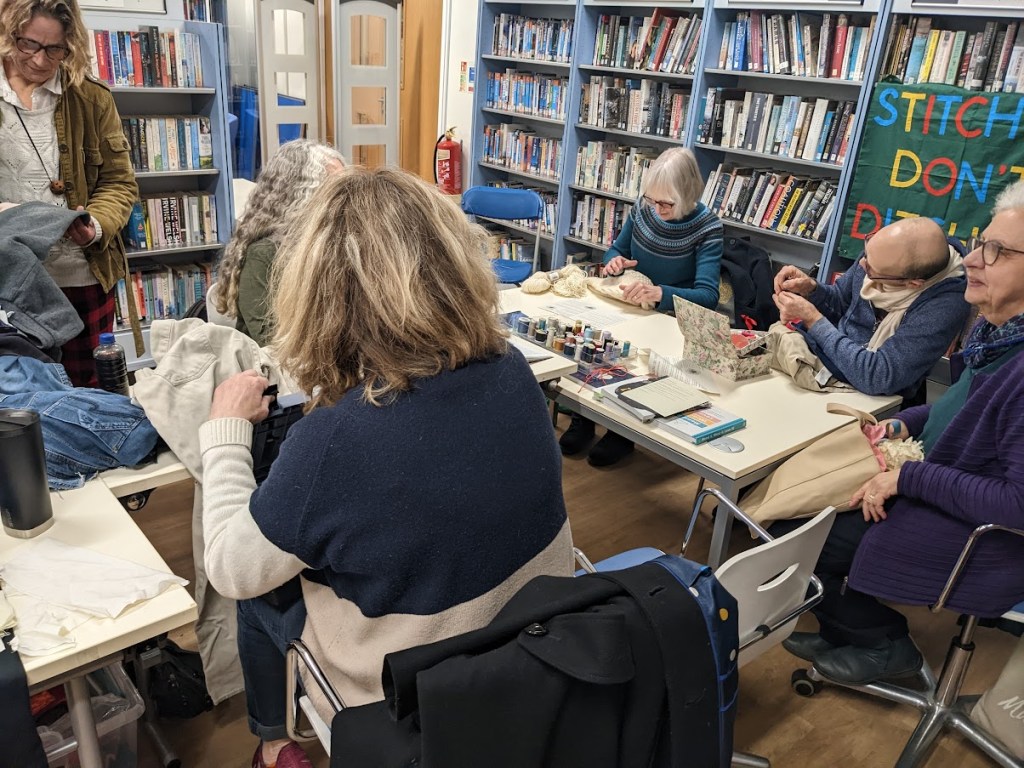Want to set up your own clothes repair group? Its great to mend together: with friends, your community or your place of worship.
Here at Ealing Repair Cafe, we are keen to see more and more repair and sewing groups popping up around London and the country. The more of us encouraging people to mend their clothes, the more change will happen.
So, here’s some ideas on how we set up our group to get you started. There are many ways of setting up a group like this so think about what you want out of your group and shape into what you feel comfortable and passionate about.
Our cafe’s principle is that people come along with their mending pile and items they are struggling to mend. They are given our guide on darning and patching, and we give them suggestions on how to mend their item. We don’t mend it for them as the point of our group is teaching them how to mend. Plus, we don’t want to put tailors out of business.
We do get the occasional person who doesn’t bring an item. So, we have scraps that they can use to practise techniques.
I have taken inspiration from this quote to motivate myself and others when starting repairing:
“Here’s my motto: Just begin. Begin this journey with whatever skills you have today and trust that you will deepen your relationship to fashion as you continue.”
Mending Matters, Katerina Rodabaugh in 2018
What’s in our sewing repair kit?
For our first few sessions, we got people to bring along their own sewing kits and some scrap fabrics and we shared between us.
Most mends are done by hand sewing rather than machine sewing. So please look at this list below, but don’t let it put you off starting a group!
Gradually we built up a stock of things below, much of it is donated. It’s amazing what you can get – from complete sewing sets to sewing machines.

It will take time to build up this list and as you run more sessions, you will learn what is most useful. Ours fits into 3 plastic boxes and we are determined to keep it just to the 3 boxes.
Here is our list in order of most used:
- Fabric scraps: A variety of stretch and non-stretch fabrics in various colours and weights plus denim scraps.
- Sewing basic notions: See our basic sewing kit for a description of the equipment. There is also some mending sewing sets available to buy, such as another mending group Fast Fashion therapy sell darning or patching kits on Etsy.
- Needles: the larger the selection the better. Look at our needle guide on what needle is what. It’s always good to invest in some good quality ones, John James Needles are a British brand are great needles. The basic needle selection is a great start. Then a few sharps and darning needle sets, and knitting wool plastic needles are good to have.
- Needle threaders: Helps thread a needle. Most sewing sets have one but many people don’t know how to use them. See sewing basic kit for description.
- Seam ripper/Unpickers: Helps to undo seams and sewing.
- Threads: There are so many threads out there. Mainly we take a variety of colours of good quality sewing and embroidery threads. For donated threads check that they are good by giving a medium pull on the thread and if it breaks it is not good enough for mends. You can keep them for tacking but not for mends.
- Darning yarn or wool: Some yarn or wool in a variety of colours are good for repairing jumpers and socks.
- Pins and safety pins: Useful to hold things in place before stitching.
- Sharp pair of scissors – Keep one pair of scissors only use for cutting fabric and thread. They will become blunt if used for cutting paper.
- Small or medium embroidery hoop: Holds fabric taut and keeps an even tension while patching or darning.
- Plastic balls/Darning mushroom or egg: Makes it easier to darn holes in curved areas (like socks).
- Stiff card (the sort that would back an A4 note pad): Makes it easier to darn flat surfaces or insert in trouser legs to avoid sewing them together.
- Tailors chalk or chalk pen for marking out grids for stitching and alterations (be careful of heat erasable pens, as these marks can ‘reappear’ when the fabric is cold.
- Ribbons and bias binding: A selection of ribbons and bias binding can help with repair and fixing edges.
- Zip mending set: Not essential but useful for those who have issues with zips. Zip Fixing kit like this can usually fix zips.
- Buttons: We have a selection of buttons for sessions, but these don’t get used as much as we imagined.
- Guide on patching and darning: We wrote up an A4 guide that on one side has patching and the other side has darning. This is offered to all who come along to our group. You can find a copy here. Online guides for patching, darning and embroidery.
- Mending and sewing books: These books help inspire and show people what is possible with mends. Also these are a good gap filler, if you have lots of people to get round you can ask the people to have a look at them while waiting for advice. We have written up these reviews of our favourites. There are so many good books out there, we are sure you will find your favourites. It’s really good to have some books that illustrate the basic stitches as for some beginners it is useful to have something visual to refer to when talking about the different stitches. We particularly like Simple alterations as the book has clear illustrations of sewing stitches and is really useful for showing how to do a certain sewing stitch.
- Samples of clothes that have mends: If you have examples of mends you have done, bring them along. We recommend this as people find it so much easier from looking at a mended item to get the concept. If you have children that are always growing out of their clothes, you can use those clothes with patches on. We also have done some samplers which helps people understand the options available. Samplers are also a lot easier to transport that full items of clothing!!



- Samplers of patching techniques: We have made some samples of styles of mends that show techniques. Here are some photos of ours.
- Signs and banners for the group: Makes it easy for people to spot the group. Also great for stalls at events and promotion. We have done ours using cross stitch and applique. The Street Stitching slogan “Stitch it, don’t ditch it” is a great one to start with it. Also a sign with your name on it is good.
- Portable rechargeable lights are great to have and useful for people who need extra lighting.
- Sewing Machines: Most mends are better done by hand sewing rather than machine sewing. Undone seams and some mends can be done on a machine. Our sewing machine is popular at our sessions, and we were lucky enough to be donated one. If you can get a sewing machine specifically for the group, it’s best. We know from experience; it can be hard watching your sewing machine being used by a beginner as they don’t always treat it as you would. If you get a sewing machine donated we would recommend getting it serviced. We have a list of local businesses offering Sewing Machine services for our area here and there might be one nearer to you, ask in local groups for recommendations.
- Travel Iron: We had a travel Iron donated after asking in a community group. I also found that there are travel iron mat which can be used instead of a ironing board and great. For iron maintenance here’s our iron cleaning guide
West London Waste offers to loan equipment such as sewing machines, rails, hangers, mirrors to help assist any local community groups with their events, such as clothes swaps or repair sessions. You can borrow these for free, if your event runs in the London Boroughs of Brent, Ealing, Harrow, Hillingdon, Hounslow and Richmond upon Thames. Contact West London Waste
Set a date and recruit like minded people
For the first meet up, gather some friends together interested in mending clothes. Hopefully some have already started mending their clothes and have a basic understanding of sewing to start with so they can share with others. We didn’t when we started this journey and we are all learning from others by running this group.
Location
Choosing a venue for your group is important. We run ours in places such as cafes, bars, museums, community group spaces, libraries or church halls. We usually look for somewhere that is free as we can never guarantee how many will turn up so it’s difficult for finances. Ideally the venue should be easily accessible and have good lighting for sewing. Low lit bars and cafes are more problematic for sewing, but if you invest in some spotlights you don’t have to depend on lighting. We found investing in some of these portable rechargeable lights are useful for people who need extra lighting.

Insurance
To run events, you need to get Public liability insurance, we are part of Ealing Transition projects and so get covered by their public liability insurance.
Promotion & Marketing
We could have a whole blog on promotion and marketing to build up the group and events.
Social media channels: There are many channels out there and the issue is that it all takes time, so prioritise what’s manageable:
- Facebook: Setting up a page for your group and then sharing posts in local groups gets interest in the group
- Instagram: Has a great community of menders out there and great for inspiration and finding out about others in your area that are doing mending.
- Nextdoor: Posted about our meet ups and had people come along
- Twitter: We haven’t set anything up but its easy to set up an account.
Setting up a website is also useful but its the biggest expense for our group. It’s an area I didn’t quite take on how much money and time it takes to manage one. We spend about £70 on annual subscriptions to our website address and wordpress. WordPress is great to get a basic website up and running. Another way is to join a community group which already has a website, where you can set up a page on their website and promote it that way.
Email list: We have built up a mailing list, using a free mailchimp account so we regularly email. Its simple to set up and can share the link on your website and other social media. Doing regular emails is time consuming so try and keep the email simple. I also look out for interesting news items and recent fixes we have helped with to also share in the email. So it becomes a useful resource for the reader.
Posters and leaflets
Design some posters and leaflets and distribute around your area to places like:
- Cafes and restaurants
- Bars and pubs
- Sewing and haberdashery shops: It’s good to make contact with them, as supporting local businesses is great on so many levels and it’s useful for recommending where people can get sewing bits who come to your group.
- Libraries
- Community Centres and places of worship
Marketing the group all takes time so not all the above is required to make a success of your group. So do what you can and feel comfortable with, as the group will gradually build up and people will start recommending you to friends.
Mending and activities
For the sessions, what we have discovered is there are so many ways to mend a piece of clothing that what the right mend is what the person would feel comfortable in wearing. If people see examples of mends and look through books, usually helps come up with a plan.
For some of the more advanced mending, it needs practice and we bring scraps of material such as denim so we can get people experimenting with the techniques. Those activities are especially good for those people who pop by to find out what the group is all about but haven’t anything to mend.
Our advice is just get out there, mend and share the love of mending. We are happy for people to contact us if you are thinking of setting up a clothes repair group.
Stitch it, don’t ditch it.


3 thoughts on “Setting up a Clothes Repair Group”